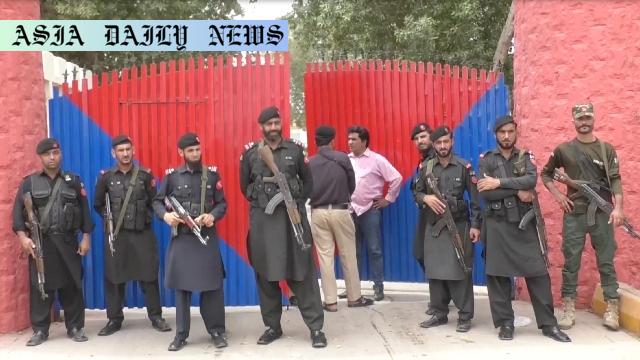Jailbreak – More than 200 inmates escaped from a Karachi prison after earthquakes caused panic, leading to a deadly shootout.
More than 200 prisoners escaped from Karachi prison amid earthquakes.
Over 80 inmates have been recaptured, while around 100 remain at large.
A deadly shootout followed, injuring officers and killing one inmate.

Massive Jailbreak Shocks Karachi Amid Earthquakes
In an alarming event on Monday night, more than 200 inmates escaped from a prison in Karachi, Pakistan, after a series of earthquakes struck the region. The prison facility, located in the coastal area of the city, became the site of chaos and panic as tremors shook its structure around 11 PM. Jail Superintendent Arshad Shah stated that the intense vibrations triggered fear among inmates, which ultimately led to a breach in security protocols. As officials attempted to move prisoners temporarily to the courtyard, some inmates saw an opportunity to escape.
The Incident and Resulting Chaos
According to local reports, the evacuated prisoners managed to overpower guards, seizing firearms in the process. This rapid escalation of events resulted in a shootout that left at least one inmate dead and three security personnel injured. The disorder coincided with the ongoing tremors, with officials scrambling to control the situation amid physical dangers and compromised infrastructure.
Authorities revealed that out of the 200 individuals who escaped, approximately 80 escapees have since been recaptured. However, over 100 remain unaccounted for at the time of reporting. This prison incident is being regarded as one of the largest jailbreaks in Pakistan’s recent history. The facility itself houses nearly 6,000 inmates, many of whom are charged with minor crimes, including narcotics possession and usage.
Security Concerns and Implications
Such a significant jailbreak raises concerns about prison security standards, especially during emergencies such as natural disasters. The government is now under scrutiny for the apparent vulnerabilities in their correctional facilities. Analysts argue that the failure to maintain strict control reflects larger systemic issues facing the country’s judicial and law enforcement systems.
This high-profile incident also highlights the importance of preparedness in disaster scenarios. Critics have called for enhanced training for prison staff and improved infrastructure to withstand emergency situations. Additionally, questions are being raised about the roles of prison authorities and guard negligence that may have contributed to inmates gaining access to firearms during a state of panic.
Moving Forward Through Reforms
Officials are currently pursuing manhunts for the escaped prisoners who remain at large. Meanwhile, government representatives promise stricter measures to prevent similar incidents in the future. The incident is expected to prompt extensive reforms in Pakistan’s penitentiary system aimed at improving crisis management and strengthening operational protocols.
The Karachi jailbreak serves as a wake-up call not only to Pakistan but to prison facilities worldwide. Striking a balance between maintaining security and ensuring the safety of inmates during disasters will require innovative approaches and critical investments in infrastructure, training, and policy redesigns.



Commentary
Analyzing the Fallout from the Karachi Jailbreak
The recent jailbreak in Karachi is a shocking event that underscores numerous vulnerabilities within Pakistan’s prison system. While earthquakes are unpredictable natural disasters that cause widespread panic, the lack of preparedness on the part of prison authorities is troubling. This incident demonstrates a critical failure in the crisis management protocols that should have been in place in such facilities. It should serve as a call to action to address not only security issues but also the human element of fear and anxiety amplified by natural calamities.
The Oversight in Emergency Preparedness
A significant concern that has surfaced post-incident is the inability of prison authorities to maintain control during an earthquake. The decision to relocate inmates temporarily to the courtyard might have seemed necessary to ensure safety, but clearly, this precautionary measure backfired. There was either an underestimation of the inmates’ capability to exploit this situation or an overconfidence in the strength of the security measures at hand. In an environment of panic, the guards faced a situation spiraling quickly out of control. Equipping staff with more emergency management training could prove crucial to mitigating such risks in the future.
Addressing Systemic Challenges
This jailbreak does not just point to lapses in one facility but highlights systemic issues within the country’s correctional infrastructure. With a reported 6,000 inmates housed in this single prison, there is a question of overcrowding and insufficient resources. Overcrowded prisons are a breeding ground for unrest, and during emergencies, they become unmanageable. Pakistan must urgently review its policies on incarceration, especially for minor crimes, to alleviate the stress on such facilities. Further investments in upgrading infrastructure to withstand natural disasters are equally important.
The Way Forward for Reforms
The Karachi incident must push Pakistani authorities to rethink their approach to prison security and emergency response. It offers an opportunity for transformative change, but only if policymakers and law enforcement acknowledge the need for comprehensive reform. This includes not just physical improvements to facilities but also operational upgrades involving better training of staff, stricter access control measures, and contingency planning for natural disasters.
In conclusion, while the jailbreak in Karachi is a staggering event with immediate implications, it offers valuable lessons for governments and correctional systems worldwide. Ensuring safety, security, and humane treatment for inmates even amidst emergencies is an aspiration that all nations should strive toward.